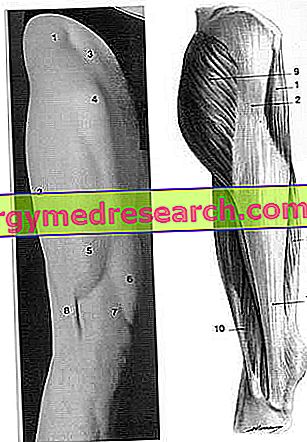By Dr. Dario Mirra
Introduction
In gyms it is very common to see the external muscles of the thighs "multi" or abductor machine "train", because the "instructors" are convinced that if the adductor muscles are located on the inside of the thigh, then the abductors must necessarily be on the thigh. 'external!
And if it wasn't really like that?

Anatomy
If we look at any anatomical table, the muscular composition of the external side of the thigh immediately turns to the eye, as in the figure to the side.
We also list the muscles:
- Tensor muscle of the fascia lata.
- Tibial ileus tract.
- Sartorius muscle.
- Rectus muscle of the femur.
- Lateral broad muscle.
- Muscle Broad medial.
- Quadriceps tendon.
- Iliothelial tract tendon.
- Large gluteal muscle.
- Hamstring muscle.
So we note that located on the outer side of the thigh we roughly have three main areas, to which they refer in principle:
- Hamstring muscle, posteriorly.
- Ileo-tibial bandellella, in the center.
- Large external (lateral) quadriceps, anteriorly.
So where are these outer-thigh muscles we train as abductors?
Physiology of lower limb abduction
Some may be disappointed but the abductor muscles of the lower limb are all located in the hip area.
We can divide them into two functional groups:
- Group first. To this group belong all the anterior muscles to the frontal plane passing through the center of the hip: anterior bundles of the middle gluteus, tensor of the fascia lata and almost the entire small gluteus. These muscles together cause an internal abduction-flexion-rotation movement.
- Group second. To this group belong the posterior bundles of the middle and small gluteus and the abductor bundles of the large buttock, all located posterior to the frontal plane. These muscles create an external abduction-extension-rotation.
It should be noted that to have a pure abduction, without any auxiliary component, it is necessary that these muscles (belonging to the two groups) work in balanced antagonist-synergistic contraction.
Why train the abductor muscles
Setting aside the hoax of the aesthetic reason, these hip muscles are fundamental for the stability of the pelvis, and as auxiliary to the movements of the thigh, and as a preventive training for hip and knee pains. In fact, this proximal articulation of the lower limb requires great stability and freedom of movement to stay healthy, in fact for Sharmann there is a 100% correlation between glute weakness and knee pain, always the same author also underlines that if a muscle has any kind of resentment not due to trauma the fault is to be found in the weakness of the agonist muscles.
Conclusions
It can be inferred that stressing the mobility and stability of the hip is important both in a rehabilitative, rehabilitative and preventive context of athletes who have had or who complain of pain in hips and knees, or who suffer from continuous contractures or strains hamstrings, both for athletic preparation for athletes who need continuous changes of direction (Rugby, Tennis, etc.)
Emphasis should be placed on these muscles also for proper Core training, as the accent is placed on the bone structures on which these muscles are inserted to train the central area of the body, then the pelvis, lumbar spine and hip, for which you can't have a strong Core if the hips and muscles that fit into it are weak.
As far as the purely aesthetic factor is concerned, instead I would lose the training of these muscles and pay more attention to the training of the lower limb, with exercises and methods that are really valid to build strength and hypertrophy in the thighs of my clients in the equipment room.
Bibliography
- Kapandji IA: Articular Physiology. Lower limb. Monduzzi Editore 2007.
- Midday V.: Text and Atlas of Human Anatomy. Piccin Editore 1999.
- Tixa S.: Atlas of Palpatory Anatomy of the Lower Arto. Elsevier Masson Editore 2005.
- Weineck J.: Sports anatomy. Mariucci Socks 2003.



